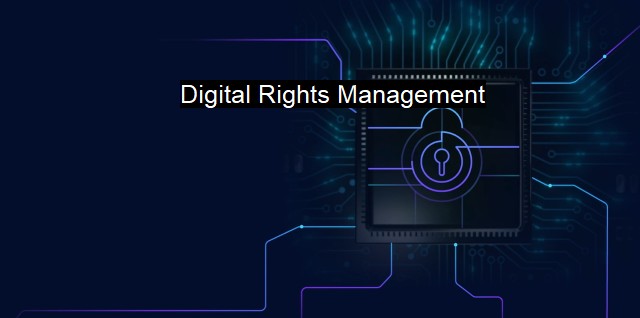What is Digital Rights Management?
Securing Digital Content with DRM and Antivirus Software: The Critical Role of Cybersecurity in Protecting Intellectual Property
Digital Rights Management (DRM) is a persistent issue in the world of cyberspace, just as much topical today as it was at the onset of digital era. Broadly speaking, DRM schemes are technological mechanisms aimed at safeguarding the copyrights of a digital content. Implemented to a variety of mediums such as software, video, audio, ebooks, and games, the underlying conviction is to protect the owners or publishers of these products from potential financial loss, enforce usage rules or to stave off unauthorized access.DRM functions as a virtual gatekeeper with prewritten codes keying usage terms of digital content. Depending on the robustness of the DRM, it might only enforce some light rules such as the number of devices an item can be installed on, to something as critical as wholly barring network access, thereby preventing the sharing of digital games on a common platform. Some DRMs are proprietary as in the case of Apple's FairPlay used for their iTunes while others are externally developed like Adobe's FlashAccess for protecting video content.
DRM comes with its complications as it creates a vulnerable loophole for online predators. Determining the downtime and uptime of DRM servers to disrupt them, hackers might circumvent the DRM codes to pave a path for successful infiltration. Consequently, the failure of DRM results not just in heavy financial repercussions but also in grave compromising of sensitive data.
Antivirus programs intervene in this nexus by implementing proactive defense mechanisms. Deploying investigative patterns to weigh the legitimacy of the DRM line of code, these antivirus software programs decompress, deobfuscate and analyse assembly instructions intricately housed in applicative binary code. Spotting suspicious patterns of malicious intent clothed in complex scripts, it severs the exposed direful threads even before the damage is set into motion.
Enhancing this protective scheme are contemporary AI-driven heuristic analysis models in cybersecurity solutions. Instead of waiting for signature definitions to be dispatched, which was the olden protocol, these predictive models gnaw suspicious files to its binary bone, employing deep learning to single out critical threats.
Yet, the debate about the beneficence of DRM is quite polarized. On one end, the legitimacy of a copyrighted product is reinforced, creators profits safeguarded, and pirated versions reduced. DRM serves shareholders needs by prolonging the shelf-life of a product. It ensures that the developers are rewarded for their creative innovations while actuating a cash flow, superbly boosting the digital economy.
But on the other hand, DRMs, particularly the proprietary types, redistribute power increasing the dependency on cloud-based servers. Growing out of the bounds of physically located DRM servers, we confront privacy complicacies along with potential data breaches. Another downside is with stiff DRM procedures besieging innocent users too bypassing flexibility. An illustration is with rich, paid eBooks advocating strictly 'no printing' or 'no copy' even for personal referencing.
Yet the cybersecurity world is unceasingly expanding and advancing protection layers. An adaptive dynamic for DRM to thrive would be coexisting with better technologies such as the blockchain for distributing keys, more effective encryption models, stern key management procedures and greater transparency. This could answer to the alarm bells of malfeasance.
DRM aspires to the noble idea of preserving the legitimate ownership of digital products. No wonder, it’s a space full of opportunities for malware to sprout, which calls for more stern, better-improved antivirus strategies that are quicker, smarter and highly capable of exacting preventive defense against mounting cyber threats. Albeit polarizing in view, it is indispensable in striking a balance between cybersecurity and the digital economy.

Digital Rights Management FAQs
What is digital rights management (DRM)?
Digital rights management (DRM) is a technology used to control and restrict the access, use, copying, and distribution of digital content, such as music, movies, and software. DRM is designed to protect the rights of copyright holders and prevent piracy and copyright infringement.Why is digital rights management important in cybersecurity?
DRM is important in cybersecurity because it helps to prevent unauthorized access to sensitive digital content and protects intellectual property rights. It also helps to prevent malware and viruses from being distributed through pirated content.What are some common types of digital rights management systems?
Some common types of DRM systems include watermarks, digital signatures, encryption, and access control mechanisms. These systems are used to enforce copyright law and protect the rights of copyright holders.Are there any ethical concerns associated with digital rights management?
Yes, there are ethical concerns associated with digital rights management, including questions about fair use, privacy, and access to information. Some argue that DRM restricts the ability of individuals to access and use information, while others argue that it is necessary to protect intellectual property rights. These concerns are the subject of ongoing debate and discussion in the cybersecurity and technology communities.| | A | | | B | | | C | | | D | | | E | | | F | | | G | | | H | | | I | | | J | | | K | | | L | | | M | |
| | N | | | O | | | P | | | Q | | | R | | | S | | | T | | | U | | | V | | | W | | | X | | | Y | | | Z | |
| | 1 | | | 2 | | | 3 | | | 4 | | | 7 | | | 8 | | |||||||